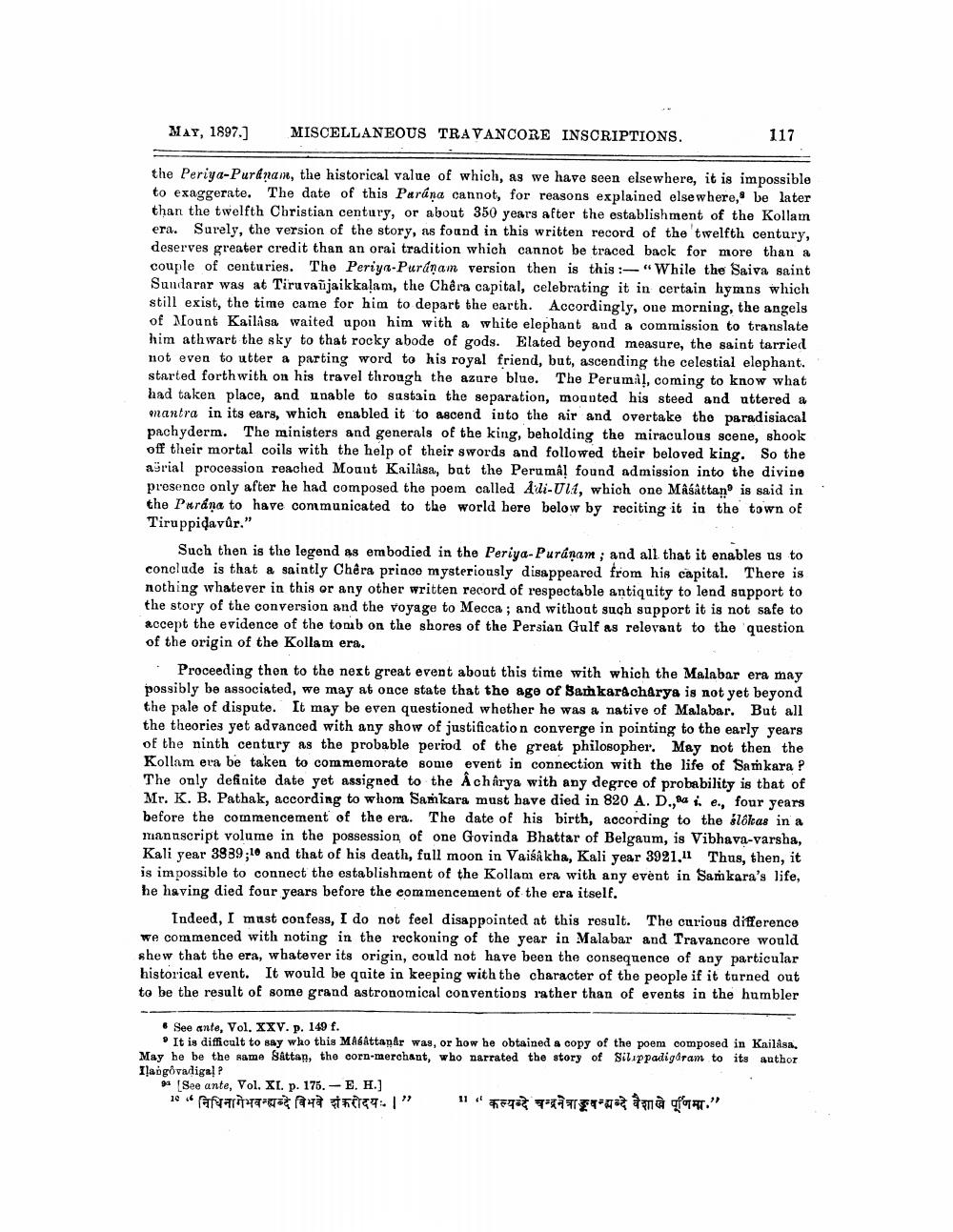________________
MAY, 1897.)
MISCELLANEOUS TRAVANCORE INSCRIPTIONS.
117
the Periya-Puranan, the historical value of which, as we have seen elsewhere, it is impossible to exaggerate. The date of this Parána cannot, for reasons explained elsewhere, be later than the twelfth Christian century, or about 350 years after the establishment of the Kollam era. Surely, the version of the story, as found in this written record of the twelfth century, deserves greater credit than an orai tradition which cannot be traced back for more than a couple of centuries. The Periya-Puranam version then is this :-"While the Saiva saint Sundarar way at Tiruvaūjaikkalam, the Chêra capital, celebrating it in certain hymns which still exist, the time came for him to depart the earth. Accordingly, one morning, the angels of Mount Kailasa waited upon him with a white elephant and a commission to translate him ath wart the sky to that rocky abode of gods. Elated beyond measure, the saint tarried not even to utter a parting word to his royal friend, but, ascending the celestial elephant. started forth with on his travel through the azure blue. The Perumal, coming to know what had taken place, and unable to sustain the separation, mounted his steed and uttered a mantra in its ears, which enabled it to ascend into the air and overtake the paradisiacal pachyderm. The ministers and generals of the king, beholding the miraculous scene, shook off their mortal coils with the help of their swords and followed their beloved king. So the aðrial procession reached Mount Kailasa, bat the Perumal found admission into the divine presence only after he had composed the poem called Ådi-U11, which one Maśattan is said in the Purana to have communicated to the world here below by reciting it in the town of Tiruppidavûr."
Such then is the legend as embodied in the Periya-Puranam ; and all that it enables us to conclude is that a saintly Chêra princo mysteriously disappeared from his capital. There is nothing whatever in this or any other written record of respectable antiquity to lend support to the story of the conversion and the voyage to Mecca; and without such support it is not safe to accept the evidence of the tonab on the shores of the Persian Gulf as relevant to the question of the origin of the Kollam era.
Proceeding then to the next great event about this time with which the Malabar era may possibly be associated, we may at once state that the age of Bankaracharya is not yet beyond the pale of dispute. It may be even questioned whether he was a native of Malabar. But all the theories yet advanced with any show of justification converge in pointing to the early years of the ninth century as the probable period of the great philosopher. May not then the Kollam era be taken to commemorate some event in connection with the life of Samkara P The only definite date yet assigned to the Acharya with any degree of probability is that of Mr. K. B. Pathak, according to whom Sankara must have died in 820 A. D., Pa 1. e., four years before the commencement of the era. The date of his birth, according to the blokas in a manuscript volume in the possession of one Govinda Bhattar of Belgaum, is Vibhava-varsha, Kali year 3839;16 and that of his death, full moon in Vaisakha, Kali year 3921.11 Thus, then, it is impossible to connect the establishment of the Kollam era with any event in Samkara's life, he having died four years before the commencement of the era itself.
Indeed, I must confess, I do not feel disappointed at this result. The curious difference we commenced with noting in the reckoning of the year in Malabar and Travancore would shew that the era, whatever its origin, could not have been the consequence of any particular historical event. It would be quite in keeping with the character of the people if it turned out to be the result of some grand astronomical conventions rather than of events in the humbler
. See ante, Vol. XXV. p. 149 f.
It is difficult to say who this MA Attanar was, or how he obtained a copy of the poem composed in Kailasa, May he be the same 8Attan, the corn-merchant, who narrated the story of Silippadigdram to its author Iļaðgövadiga!?
[See ante, Vol. XL. p. 175.-E. H.) 10 Farina T.1" 11" eta Ta m
."




